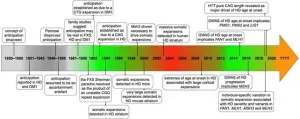(Press-News.org) Amsterdam, February 11, 2021 - Recent genetic data from patients with Huntington's disease (HD) show that DNA repair is an important factor that determines how early or late the disease occurs in individuals who carry the expanded CAG repeat in the HTT gene that causes HD. The processes of DNA repair further expand the CAG repeats in HTT in the brain implicated in pathogenesis and disease progression. This special issue of the Journal of Huntington's Disease (JHD) is a compendium of new reviews on topics ranging from the discovery of somatic CAG repeat expansion in HD, to our current understanding of the molecular mechanisms involved and the development of potential new therapies targeting these mechanisms.
The CAG expansion varies from 6 to 35 repeats in HTT on chromosomes of unaffected individuals and from more than 36 to greater than 180 repeats in HD patients.
"The CAG repeat mutation in the HTT gene that causes HD was discovered in 1993. Although our understanding of the underlying biology and our ability to model many aspects of the disease have improved substantially, no treatment that alters the course of this devastating disorder has been found," explain Guest Editors Lesley Jones, PhD (Cardiff University, UK), Vanessa Wheeler, PhD (Massachusetts General Hospital, USA), and Christopher E. Pearson, PhD (The Hospital for Sick Children, University of Toronto, Canada).
Recent advances in genetics have now transformed our understanding of the factors that are critical in the pathogenesis of HD and are beginning to provide similar insight into other repeat expansion disorders such as Friedreich's ataxia, myotonic dystrophy and many of the repeat-expansion spinocerebellar ataxias. This special issue of JHD provides an important and novel synthesis of the wealth of HD research information and the knowledge of DNA repair and somatic repeat expansion in HD. This has the potential to help drive discovery forward, leading to new treatments and improved quality of life and outcomes for individuals with HD.
The genetic findings presented in this issue examine data in HD, HD models and other diseases and make sense of many previous findings with respect to how DNA repair genes altered the disease in mice. This has highlighted HD biology that can be used to generate new targets for development of drugs to treat the disease. It may eventually allow a better prediction of the clinical course of HD in specific individuals and improve the power of clinical trials enabling shorter trials or trials with fewer participants.
The findings presented in this issue imply that the expanded CAG repeat in HD causes disease through a two-part process. A review entitled "Huntington's Disease Pathogenesis: Two Sequential Components" outlines how the compelling genetic data that highlight DNA repair and somatic expansion are critically important in the manifestation of HD. It also explores the implications of these data for mechanisms underlying disease pathophysiology. The authors propose that two steps are required for pathogenesis in HD: first an expansion of the HTT CAG repeat in somatic cells, followed by downstream pathogenic events occurring in response to those CAG repeats in cells that are expanded from the inherited length. The authors share access to their website allowing other investigators to explore recent genetic data interactively to support their own research
"The identification of the HD gene has not yet led to an effective treatment, but continued human genetic analysis of genotype-phenotype relationships in large HD subject populations, first at the HTT locus and subsequently genome-wide, has provided insights into pathogenesis that divide the course of the disease into two sequential, mechanistically distinct components," comments author James F. Gusella, PhD, Massachusetts General Hospital and Harvard Medical School.
Although linking the genetic findings in HD to functional biological systems and then to their actual effect on disease onset or course has been challenging, many pharmaceutical companies, large and small, are now working on the new targets identified by these findings. "Drugging DNA Damage Repair Pathways for Trinucleotide Repeat Expansion Diseases" highlights and addresses the multiple challenges that will need to be overcome to generate new therapeutics or repurposing existing therapeutics that can tackle DNA repair and somatic expansion of the CAG repeat. It illustrates the gaps in our knowledge that we really need to fill to use these findings to generate novel and effective drugs for somatic expansion in HD and potentially other repeat disorders.
"The development of novel DNA damage response (DDR) drugs for neurodegeneration is also facilitated by understanding of challenges with DDR drugs for oncology and key liabilities associated with specific targets," notes lead author Caroline L. Benn, PhD, LoQus23 Therapeutics. "We need to maintain a watching brief, continue to address the gaps in our understanding, and ensure we continue to work to realize the potential to increase therapeutic benefit and reduce risk. Taken together, we believe success is possible with close collaboration between patients, academic investigators, preclinical drug discoverers, clinicians, diagnostic developers and regulatory bodies."
"We hope that our colleagues in the global HD research community find this special issue educational and stimulating and that it serves to speed discovery and treatments. We learned a lot - we hope our readers do likewise!" add the Guest Editors.
INFORMATION:
Co-Editors-in-Chief Blair R. Leavitt, MD (The University of British Columbia) and Leslie M. Thompson, PhD (University of California Irvine) have dedicated this special issue in memory of Professor Sir Peter Harper (1939-2021). A visionary geneticist, he was instrumental in the discovery of the repeat mutations causing HD and myotonic dystrophy. "Prof. Harper continued to influence the HD field though his perceptive anticipation of what these genetic discoveries would mean for patients, their families and the direction of HD research. He was a generous and engaged mentor to a whole generation of clinical and non-clinical researchers in HD and other repeat disorders, and his legacy will continue to inspire future generations," adds Prof. Jones, a long-time colleague and protégé.
In the last 25 years, scientists have discovered over 4000 planets beyond the borders of our solar system. From relatively small rock and water worlds to blisteringly hot gas giants, the planets display a remarkable variety. This variety is not unexpected. The sophisticated computer models, with which scientists study the formation of planets, also spawn very different planets. What the models have more difficulty to explain is the observed mass distribution of the planets discovered around other stars. The majority have fallen into the intermediate mass category - planets with masses of several Earth masses to around that of Neptune. Even in ...
LAWRENCE -- Nearly every fall, as football teams return to the field, tragic stories of players falling ill and even dying of heat trauma make the headlines. What many don't consider is that marching band members -- who don heavy uniforms and perform in the same sweltering temperatures -- may also be at risk.
A study led by the University of Kansas has measured core temperatures, hydration and sweat levels of marching band members and found that they are very much at risk and deserve access to athletic trainers for their safety -- just as players do.
The study used high tech methods to gauge band members' body core ...
A study led by researchers at Baylor College of Medicine reveals a novel role of the steroid receptor coactivator 3 (SRC-3/NCOA3), a protein crucial for steroid hormone function and a prognostic marker for aggressive human breast and other cancers.
The team discovered that SRC-3 also regulates human immune T regulatory cells (Tregs), which contribute to the regulation of the body's immunological activity by suppressing the function of other immune cells, including those involved in fighting cancer. The study, which appears in the journal Scientific Reports, shows that Tregs whose SRC-3 function was eliminated failed to suppress the activity of other immune cells in the lab. The authors anticipate that their findings ...
The golden-mantled ground squirrel (Callospermophilus lateralis) is a popular sight among tourists in the Rocky Mountains--the small rodent is a photogenic creature with a striped back and pudgy cheeks that store seeds and other food.
But there's a reality that Instagram photos don't capture, said Christy McCain, an ecologist at the University of Colorado Boulder. In a new study spanning nearly 13 years, she and her colleagues discovered that the ground squirrel has joined many other small mammals in Colorado's Rocky Mountains that are making an ominous trek: They're climbing uphill to avoid warming temperatures in the state brought on by climate change.
"It's frightening," ...
Globular clusters are extremely dense stellar systems, in which stars are packed closely together. They are also typically very old -- the globular cluster that is the focus of this study, NGC 6397, is almost as old as the Universe itself. It resides 7800 light-years away, making it one of the closest globular clusters to Earth. Because of its very dense nucleus, it is known as a core-collapsed cluster.
When Eduardo Vitral and Gary A. Mamon of the Institut d'Astrophysique de Paris set out to study the core of NGC 6397, they expected to find evidence for an "intermediate-mass" black hole (IMBH). These are smaller than the supermassive black holes that lie at the cores of large galaxies, but larger than stellar-mass black holes ...
Rheumatic heart disease (RHD) develops as a long term complication of childhood streptococcal angina. Latent RHD can be detected with echocardiography years before it becomes symptomatic. RHD is curable when treated early with medication.
RHD is responsible for over 300 000 deaths worldwide each year, accounting for just over two-thirds of all deaths from valvular heart diseases. RHD is disproportionally prevalent across sub-Saharan Africa, South Asia and the Pacific Islands and largely a phenomenon of marginalized communities in developing and emerging countries whereas ...
Millions of tonnes of plastic waste find their way into the ocean every year. A team of researchers from the Institute for Advanced Sustainability Studies (IASS) in Potsdam has investigated the role of regional ocean governance in the fight against marine plastic pollution, highlighting why regional marine governance should be further strengthened as negotiations for a new global agreement continue.
In recent years, images of whales and sea turtles starving to death after ingesting plastic waste or becoming entangled in so-called ghost nets have led to a growing ...
Domestic cats are a major threat to wild species, including birds and small mammals. But researchers reporting in the journal Current Biology on February 11 now have evidence that some simple strategies can help to reduce cats' environmental impact without restricting their freedom. Their studies show that domestic cats hunt less when owners feed them a diet including plenty of meat proteins. Equally, it helps to play with them each day in ways that allow cats to mimic hunting.
"While keeping cats indoors is the only sure-fire way to prevent hunting, some owners ...
Domestic cats hunt wildlife less if owners play with them daily and feed them a meat-rich food, new research shows.
Hunting by cats is a conservation and welfare concern, but methods to reduce this are controversial and often rely on restricting cat behaviour in ways many owners find unacceptable.
The new study - by the University of Exeter - found that introducing a premium commercial food where proteins came from meat reduced the number of prey animals cats brought home by 36%, and also that five to ten minutes of daily play with an owner resulted ...
Cambridge, MA - February 11, 2020 - Dyno Therapeutics, a biotech company applying artificial intelligence (AI) to gene therapy, today announced a publication in Nature Biotechnology that demonstrates the use of artificial intelligence to generate an unprecedented diversity of adeno-associated virus (AAV) capsids towards identifying functional variants capable of evading the immune system, a factor that is critical to enabling all patients to benefit from gene therapies. The research was conducted in collaboration with Google Research, Harvard's Wyss Institute for Biologically Inspired Engineering and the Harvard Medical School laboratory of George M. Church, Ph.D., a Dyno scientific co-founder. The publication is entitled "Deep diversification ...






